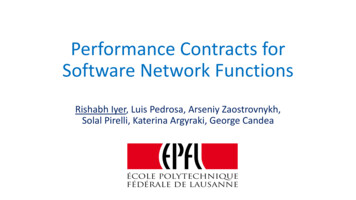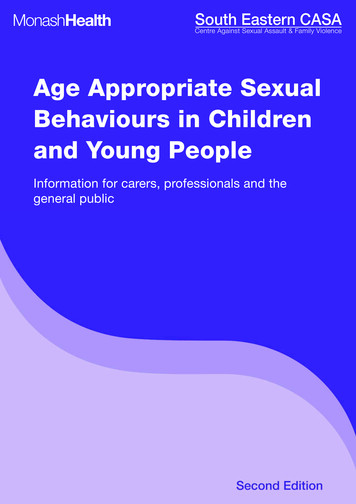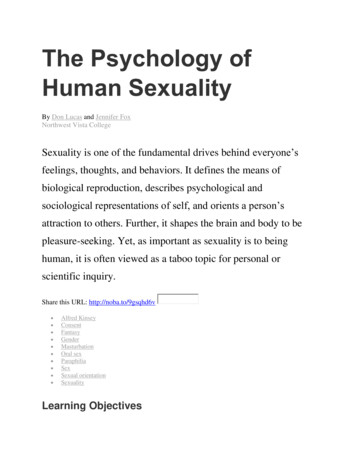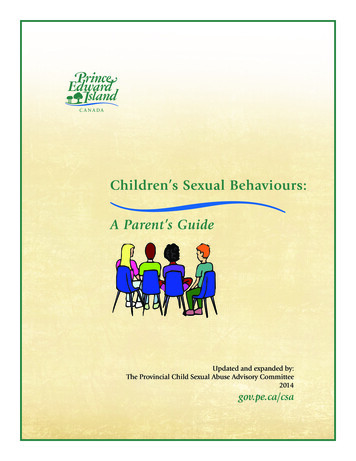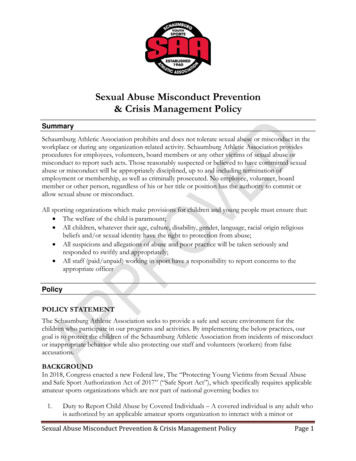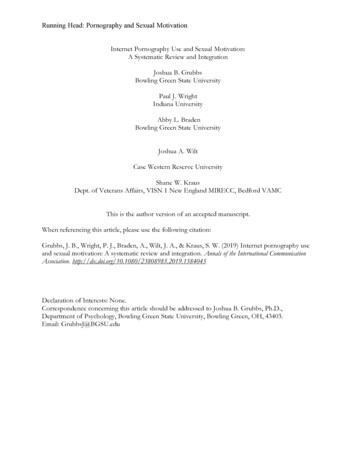
Transcription
Running Head: Pornography and Sexual MotivationInternet Pornography Use and Sexual Motivation:A Systematic Review and IntegrationJoshua B. GrubbsBowling Green State UniversityPaul J. WrightIndiana UniversityAbby L. BradenBowling Green State UniversityJoshua A. WiltCase Western Reserve UniversityShane W. KrausDept. of Veterans Affairs, VISN 1 New England MIRECC, Bedford VAMCThis is the author version of an accepted manuscript.When referencing this article, please use the following citation:Grubbs, J. B., Wright, P. J., Braden, A., Wilt, J. A., & Kraus, S. W. (2019) Internet pornography useand sexual motivation: A systematic review and integration. Annals of the International CommunicationAssociation. laration of Interests: None.Correspondence concerning this article should be addressed to Joshua B. Grubbs, Ph.D.,Department of Psychology, Bowling Green State University, Bowling Green, OH, 43403.Email: GrubbsJ@BGSU.edu
Pornography and Sexual MotivationInternet Pornography Use and Sexual Motivation:A Systematic Review and IntegrationJoshua B. Grubbs, Paul J. Wright, Abby Braden, Joshua A. Wilt, Shane W. Kraus2AbstractPornography use is a common activity in the developed world. This work consolidates research about pornography use into anorganizational structure that is relevant to sexual motivation more broadly. To accomplish this, a comprehensive review of research isconducted, examining personality, emotional, and attitudinal associates and predictors of pornography use, as well as behaviors, attitudes,and motivations that are associated with or predicted by pornography use. Reviewing over 130 studies, the present work demonstratesthat pornography is most often consumed for pleasure-seeking purposes, that it associated with increases in casual or impersonalapproaches to sexuality, and that it predicts more pleasure-oriented approaches to sexual behavior. The implications of these findings arediscussed.Sexually explicit forms of media—pornography—have existed for millennia. However,technological advances over recent decades (i.e., theinternet) have revolutionized the distribution andconsumption of such media. Globally, internetpornography use (hereafter: IPU internetpornography use; IP internet pornography) is acommon phenomenon (Ogas & Gaddam, 2011; Price,Patterson, Regnerus, & Walley, 2016; Regnerus,Gordon, & Price, 2016). Internationally, substantialmajorities of individuals have viewed internetpornography (e.g., Sweden, Canada, Germany, andU.S., 77% of college students; Döring, Daneback,Shaughnessy, Grov, & Byers, 2017; Australia, 84% ofmen and 54% of women Rissel et al., 2017).Furthermore, in nationally representative studies, up to46% of adult men in the U.S. and 16% of adult womenreport intentional IPU in any given week (Regnerus etal., 2016). A number of recent works confirm that theseviewing patterns are extremely common amongadolescents as well (e.g., Taiwan, 74% of adolescentboys and 26% of adolescent girls, Chen, Leung, Chen,& Yang, 2013; Sweden, 96% of adolescent boys,Mattebo, Tydén, Häggström-Nordin, Nilsson, &Larsson, 2013; U.S. 50% of adolescents Rasmussen &Bierman, 2016). Various reports have placed IP as thelargest single category of electronic media both in termsof total bandwidth and total traffic (Misra, 2014), withthe most popular online pornography website boastingover 3,732 petabytes (over three billion gigabytes) ofdownloads in 2017 alone (Pornhub, 2018). In short, theconsumption of IP is a common activity for manyadults and adolescents worldwide, with a frequency thatis unprecedented by previous forms of erotic media.Given the prevalence of IPU, it is notsurprising to see that it is also often a topic of academicinquiry. Over recent years, there has been an increase inpeer-reviewed literature examining IP frompsychological (for reviews, see: Peter & Valkenburg,2016; Short, Black, Smith, Wetterneck, & Wells, 2012),sociological (Brickell, 2012), anthropological(Vucurovic, 2013), and even philosophical (Watson,2010) perspectives. However, despite the ubiquity ofpornography use in developed nations, to date, themajority of publications and empirical studies of IPUhave been relegated to topical journals and specialinterest publications. Herein, we seek to consider thisbehavior in terms that are relevant to psychological andcommunication sciences more broadly.Internet Pornography Use and Sexual MotivationInternet pornography use is a sexual behavior.That is, people most often view pornography for sexualpurposes (Solano, Eaton, & O’Leary, 2018) anddescribe their use of pornography as being relatedother aspects of their sexual attitudes, beliefs,preferences, and behaviors (Attwood, 2005; Kohut,Fisher, & Campbell, 2017; Rissel et al., 2017). In thedecades following the advent and widespread use of theinternet, a plethora of empirical research has beenpublished examining how IPU is related to variousaspects of sexuality (Grubbs & Perry, 2019; Harkness,Mullan, & Blaszczynski, 2015; Peter & Valkenburg,2016). Building on this, the purpose of the presentwork was to conduct a systematic and integrativereview that contextualizes pornography within thegreater context of human sexual motivation.Specifically, we sought to examine what factors (bothsexual and non-sexual) predict IPU and the ways inWhen referencing this article, please use the following citation:Grubbs, J. B., Wright, P. J., Braden, A., Wilt, J. A., & Kraus, S. W. (2019) Internet pornography use and sexual motivation: A systematic review and integration. Annals of theInternational Communication Association. http://dx.doi.org/10.1080/23808985.2019.1584045
Pornography and Sexual Motivation3studies that focused exclusively on problematic oraddictive use of pornography, studies that were limitedto clinical or treatment seeking populations, studies thatfocused exclusively on non-internet pornography (e.g.,studies before 1998), studies that focused exclusivelyon paraphilic or pedophilic pornography use, casestudies or reports, and studies that did not focus onhuman subjects directly (e.g., content analyses ofpornography websites). This process led to theinclusion of 134 studies.Methodological ConcernsBefore engaging in such a systematic review, itis important to acknowledge the methodologicalcritiques of research to date. Below, we consider threesuch concerns: gender, morality, and negative bias.GenderOne of the greatest limitations of researchrelated to IPU is that such research tends to be genderconstricted. A vast number of studies regarding IPUhave focused on such use in men alone (Duffy,Dawson, & das Nair, 2016; Short et al., 2012). Thismale-centric focus is warranted to a degree, as womenreportedly use pornography at rates much lower thanmen do (Regnerus et al., 2016), which is likely afunction of multiple factors such as a grander culturaltrend in which women’s sexual motivation is oftensecondary to the male sexual drive (Baumeister, 2000,2004; Baumeister, Catanese, & Vohs, 2001; Baumeister& Twenge, 2002; Baumeister & Vohs, 2004), moreuniversal differences in male vs. female sexuality(Peplau, 2003; Petersen & Hyde, 2010; Schmitt &International Sexuality Description Project, 2003), andthe fact that much of currently available pornography ismarketed toward male audiences (French & Hamilton,2018). Another possibility is that women may alsounderreport their IPU due to cultural norms aroundsexuality and gender roles, and there is good evidencethat significant numbers of women do use IP withsome regularity (16-17% of adult women in the U.S.report use within the past week or month Grubbs,1include studies only reporting gender as a predictor ofuse, instead focusing on works that identified individualdifference variables that are associated withpornography use, self-reported reasons forpornography use, or evidence of pornography use forspecific reasons.which IPU influences, predicts, or is associated withsexual attitudes, beliefs, and behaviors. More to thepoint, we examined what factors predict IPU (a sexualbehavior) and how IPU, in turn, seems to influencevarious dimensions of the human sexual experience.To accomplish these goals, we conducted asystematic review of available literature on IPU. To beincluded, the study had to examine the associationbetween IPU and at least one other variable relevant tosexual motivation, attitudes, or behaviors. Studies thatonly examined gender as a correlate of IPU wereexcluded.1 Cross-sectioonal and longitudinalinvestigations were included. To this end, weconducted a search of available academic literature,specifically querying the following databases: AcademicSearch Complete, Academic Search Premier,MEDLINE, Psychology and Behavioral SciencesCollection, PsycINFO, SocINDEX, CINAHL, andPubMed. All searches included the initial terms,“internet” and “pornography,” which were followed bya number of search terms that were meant to assess thevariables of interest. These additional terms were:“reason*,” “predict*,” “outcome,” “behavior,”2“personality,” “motiv*,” “trait,” “risk,” “attitude,”“longitudinal,” “effect,” and “future.” These initialsearch parameters returned over 1,000 results that werethen screened for inclusion. The results of this revieware summarized, according to PRISMA guidelines(Moher, Liberati, Tetzlaff, & Altman, 2009), in Figure1.After deleting duplicates, removing irrelevant ornon-academic works, and screening out studies that didnot involve empirical research, we then reviewed thefull texts of over 275 papers for inclusion in our finalreview. We elected to only include studies that eitherexamined personality and motivational associates andpredictors of IPU or studies for which IPU was framedas an associate or predictor of a behavioral (e.g., sexualactivity) or attitudinal (e.g., sexual values, acceptance ofsexual behaviors) outcome. We specifically omittedAcross numerous studies in several cultural settings,the greatest predictor of pornography consumption ismale gender (e.g., Grubbs, Kraus, & Perry, 2019;Rasmussen & Bierman, 2017; Regnerus, Gordon, &Price, 2016; Rissel et al., 2017; Vanwesenbeeck I,Bakker F, & Gesell S, 2010; Wright, 2013; Wright, Bae,& Funk, 2013). For the present review, we did not2We also searched for “behaviour”When referencing this article, please use the following citation:Grubbs, J. B., Wright, P. J., Braden, A., Wilt, J. A., & Kraus, S. W. (2019) Internet pornography use and sexual motivation: A systematic review and integration. Annals of theInternational Communication Association. http://dx.doi.org/10.1080/23808985.2019.1584045
Pornography and Sexual MotivationKraus, & Perry, 2019; Regnerus et al., 2016). In short,the male-centric approach to IP research to date hashampered understandings of women’s use. As such, weprovide gender breakdowns for each sample reviewedin this paper, and note areas in which gender is ofparticular importance.Morally charged Subject MatterAnother noted limitation of IP research is relatedto the morally charged nature of the topic (Fisher,Montgomery-Graham, & Kohut, 2018; Grubbs &Perry, 2019; Grubbs, Perry, Wilt, & Reid, 2018).Numerous analyses have found that both personalmorality and religious beliefs dramatically impactattitudes toward IP use (Droubay, Butters, & Shafer,2018; Grubbs, Exline, Pargament, Hook, & Carlisle,2015; Grubbs, Wilt, Exline, Pargament, & Kraus, 2018;Short, Kasper, & Wetterneck, 2015). Religiousindividuals tend to broadly disapprove of IP use(MacInnis & Hodson, 2016) and support thecensorship of pornography in various forms (Droubayet al., 2018; Lambe, 2004). Not surprisingly then,religious individuals report using IP at rates muchlower than the general population (Perry, 2017;Rasmussen & Bierman, 2017; Wright, 2013; Wright,Bae, & Funk, 2013). Yet, despite these associations,there are several studies indicating that religiousindividuals do indeed use IP (MacInnis & Hodson,2015; L. J. Nelson, Padilla-Walker, & Carroll, 2010;Perry, 2015), often with great emotional distress(Grubbs et al., 2019; Patterson & Price, 2012; Volk,Thomas, Sosin, Jacob, & Moen, 2016). Given theseassociations, religiosity and moral values should beconsidered relevant covariates in research on IP use.Yet, these factors have not been considered frequentlyenough in formal analyses, limiting the generalizabilityof current research.Negative BiasFinally, another key limitation of pornographyresearch is the seemingly negative bias of such research(Fisher & Barak, 2001; Fisher et al., 2018; Ley, Prause,& Finn, 2014; Montgomery-Graham, Kohut, Fisher, &Campbell, 2015), with little research examining whetherthere could be positive aspects of IP use. Inherentlythen, there is likely a bias in available studiesdemonstrating either negative or neutral effects of IPconsumption, with very little prior researchdemonstrating, or even attempting to measure, positiveeffects (Kohut & Campbell, 2019).4Factors Motivating or Predicting InternetPornography UseIn the first part of this review, we consider thevarious factors that may motivate the consumption ofinternet pornography, with special attention paid tostudies presenting evidence of factors that are likely todrive pornography use. This method resulted in theidentification of 34 studies falling into three broadcategories, as described below.Individual difference variables. Across anumber of studies—particularly earlier studies (e.g.,before 2010) of IPU—personality characteristics andindividual difference variables consistently emerged aspredictors of IPU. These findings are detailed in Table1, though we review the general findings below.Dispositional sexual affect. Dispositionalsexual affect is a term for personality factors that leadindividuals to respond to sexual stimuli in a predictableway (Gunter, 2001). It often refers to the erotophobiaerotophilia spectrum (Paul, 2009) that ranges fromnegative attitudes toward impersonal sex (e.g.,disinterest in strippers or pornography) to morepositive attitudes toward impersonal sex (e.g., casual orgroup sex), including pornography specifically (Fisher,White, Byrne, & Kelley, 1988). Higher levels oferotophilia are associated with pleasure-seekingmotivations for sexual activity in general (Birnbaum &Gillath, 2006; Cooper, Shapiro, & Powers, 1998), and agreater propensity to pursue sexual pleasure.As reviewed in Table 1, U.S. studies show thathigher erotophilia predicts greater motivation to engagein IPU, greater arousal from IPU (Paul, 2009), andgreater probability of responding to unsolicited IP withmore IP search behaviors (Shim, Lee, & Paul, 2007).These tendencies seem to hold in contexts outside theU.S. as well (e.g., Lima, Peru; Velezmoro, Negy, &Livia, 2012).Sensation-seeking. Across a number ofstudies, sensation-seeking is a common predictor ofIPU, in both U.S. and international contexts using bothcross-sectional and longitudinal designs (See Table 1).This is notable, given that sensation-seeking is apleasure-seeking drive (Hirschman & Holbrook, 1982;Zuckerman, 1994, 2014), that predicts pleasure-seekingbehaviors in general (Comeau, Stewart, & Loba, 2001;Magid, MacLean, & Colder, 2007) and sexual behaviorsspecifically (Kalichman & Rompa, 1995). Notsurprisingly then, a number of studies identifiedWhen referencing this article, please use the following citation:Grubbs, J. B., Wright, P. J., Braden, A., Wilt, J. A., & Kraus, S. W. (2019) Internet pornography use and sexual motivation: A systematic review and integration. Annals of theInternational Communication Association. http://dx.doi.org/10.1080/23808985.2019.1584045
Pornography and Sexual Motivationsensation-seeking as a consistent predictor of IPU,both cross-sectionally and over time.Narcissistic traits. In addition to dispositionalsexual affect and sensation-seeking, narcissistic traitshave also been linked to IPU. For example, entitlementis a self-focused trait that is a key component ofnarcissism more broadly (W. K. Campbell, Bonacci,Shelton, Exline, & Bushman, 2004; Grubbs & Exline,2016). Generally speaking, entitlement is associatedwith a desire for pleasure and enjoyable experiencesand it often predicts selfish behaviors (Bushman,Moeller, & Crocker, 2011; W. K. Campbell et al., 2004).At least a few studies have noted that trait entitlement,narcissism, and sexual narcissism are each crosssectionally and retrospectively associated with greaterlevels of reported pornography use. Collectively, thesestudies, alongside previously reviewed studies, suggestthat self-focused traits such as dispositional sexualaffect, sensation-seeking, and narcissism are allassociated with IPU (See Table 1).Self-Reported Reasons for IPUIn addition to research on dispositionalcorrelates of IPU, many studies have directly evaluatedself-reported reasons for IPU. Below, we consider themajor findings in this domain.Arousal and enhancement. IPU results insexual arousal (Brand et al., 2010; Goodson,McCormick, & Evans, 2000, 2001; Hald, Malamuth, &Lange, 2013). Not surprisingly then, sexual arousal andsexual enhancement are consistently reported aspredominant reasons for using pornography (See Table2). Specifically, masturbation enhancement (Wallmyr &Welin, 2006), sexual arousal (Baltazar, Helm, McBride,Hopkins, & Stevens, 2010), and more general pleasureseeking goals (Paul & Shim, 2008) are all commonlyreported as the predominant motivation forpornography consumption. Self-reported hedonicmotivations for pornography use are also evident inrecent work attempting to classify pornography usersby their reasons for viewing pornography (C. C.Brown, Durtschi, Carroll, & Willoughby, 2017). Finally,these findings also persist outside of Western contexts(Chen et al., 2013).Curiosity and information-seeking. Anumber of studies also note that a commonly reportedmotivation for IPU is education, curiosity, orinformation (e.g., Chen et al., 2013; Paul & Shim,2008). Individuals may report a desire to learn new5sexual positions, new sexual practices, or generally gaina better understanding about sexual activity in general(Attwood, 2005; Weinberg, Williams, Kleiner, &Irizarry, 2010). Given that curiosity is a less commonlyendorsed reason for viewing IP than directly hedonicreasons (C. C. Brown, Durtschi, et al., 2017), curiosityis not likely the most common motivation for use,particularly among frequent users. Additionally, insome ways, curiosity and information-seeking may alsobe seen as pleasure-seeking drives (Kashdan, Rose, &Fincham, 2004; Kashdan & Steger, 2007; Litman,2005). New information can be both liked and wanted(Litman, 2005), and the hedonic value of newinformation can be predictive of the individual’sengagement with it (Higgins, 2006). As such, althoughthis reason is less commonly endorsed than arousal,pleasure, or masturbatory aid, it may be another formof pleasure-seeking motivation for pornography use.Intimacy and coupling motives. Anotherpotential motivation for IPU would be intimacy orrelationship goals. A number of prior theories of sexualmotivation (e.g., Cooper et al., 1998; Baumeister &Tice, 2001) have cited intimacy and relationship goalsas important impetuses for sexual drive. These motivesare particularly common for women (Basson, 2000;Peplau, 2003) and often serve as the primarymotivation for sexual activity (Cooper et al., 1998). Assuch, the role of such goals in motivating any sexualbehavior cannot be understated.Some men and women in heterosexualrelationships report viewing IP with their partner(Daneback, Træen, & Månsson, 2009; Olmstead,Negash, Pasley, & Fincham, 2013; Poulsen, Busby, &Galovan, 2013; Resch & Alderson, 2014). Oftentimes,the motivation for this use is to satisfy a partner orenhance a sexual relationship. However, IPU with aromantic partner is less common (Poulsen et al., 2013),as less than 20% of men report ever using pornographywith a partner, compared to 90% of men who reportusing alone (Kraus & Rosenberg, 2014, 2016). More tothe point, coupled use of pornography is likely not aprimary motivation for regular IPU for the majority ofusers. Having said this, recent qualitative researchsuggests that young adults are increasingly expectingpornography use to be a part of their futurerelationships (Kohut et al., 2017), which may indicatethat this motivation for pornography consumption willchange in coming years.When referencing this article, please use the following citation:Grubbs, J. B., Wright, P. J., Braden, A., Wilt, J. A., & Kraus, S. W. (2019) Internet pornography use and sexual motivation: A systematic review and integration. Annals of theInternational Communication Association. http://dx.doi.org/10.1080/23808985.2019.1584045
Pornography and Sexual MotivationCoping. In addition to enhanced pleasure, thereduction or avoidance of dysphoric or unpleasantstates is also a powerful motivation for a variety ofbehaviors (Elliot & Covington, 2001; Ryan & Deci,2001). Importantly, this motivation is also a consistentpredictor of greater pornography use. That is, across avariety of studies (See Table 3), mood management andstress relief are consistently endorsed as reasons forIPU, as are feelings of psychological distress and/orloneliness more generally. Importantly, these findingsare both cross-sectional and longitudinal (Peter &Valkenburg, 2011b), suggesting a potential causal linkbetween lower mood states and the use of pornographyas a coping mechanism. We also note that problematicpornography use (though not the focus of this review)is also commonly predicted by the use of pornographyto cope with or avoid negative emotions (Reid, Li,Gilliland, Stein, & Fong, 2011).Boredom. Continued evidence for IPU forpain reduction or avoidance is also present in researchrelated to boredom and IPU (See Table 3). Boredom isconsidered a unique and undesirable psychological state(Goldberg, Eastwood, LaGuardia, & Danckert, 2011)that is distressing (Martin, Sadlo, & Stew, 2006).Consequently, people are often highly motivated toavoid boredom (Pekrun, Goetz, Daniels, Stupnisky, &Perry, 2010), often through a variety of pleasureseeking behaviors, such as gambling (Neighbors,Lostutter, Cronce, & Larimer, 2002), eating (Macht,2008), drug use (Boys, Marsden, & Strang, 2001), andmasturbation (Carvalheira, Træen, & Stulhofer, 2015;Janssen, McBride, Yarber, Hill, & Butler, 2008). Inkeeping with this trend, a number of studies do suggestthat boredom is often a motivation for pornographyuse (See Table 3).Summary of Motivations for IPUA number of factors may motivate IPU, butpleasure-focused motives seem to be the most robustand obvious of these factors. Self-focused, individualdifference variables, such as entitlement and sensationseeking, often predict IPU; and people most oftenreport viewing IP to enhance arousal and pleasure or toescape negative affective states. These findings areparticularly true of men, for whom sexual arousal,sexual excitement, and masturbation were the mostconsistent predictors of use. For women, pleasurefocused motivations were also common, thoughtypically endorsed at lower rates than men. Such a6finding is consistent with the broader literaturesuggesting that men tend to be more pleasuremotivated in sexual behavior than women (Cooper etal., 1998). Although certain exceptions to thismotivation certainly exist (e.g., individuals watching IPas a couple), self- focused pleasure-seeking motivesseem to predict general desire to consume IP and theconsistency of such consumption better than otherfactors (Paul & Shim, 2008; Solano et al., 2018).Despite the consistency of these results, themajority of studies described in Tables 1-3 are crosssectional and retrospective in nature. That is, the vastmajority of findings on the individual differences andself-reported reasons that predict pornography use arebased on temporally static, past recall dependentmethods, rather than on prospective longitudinal orexperimental designs. The notable exceptions to thesetrends are the few longitudinal studies documentingthat psychological distress seems to predictpornography use over time (Peter & Valkenburg,2011b) and the studies that show that sensation-seekingprospectively predicts greater pornography use overtime (Beyens, Vandenbosch, & Eggermont, 2015; Peter& Valkenburg, 2011b). As such, there is a need forfuture longitudinal and experimental work thatexplicitly test the causal mechanisms motiving greaterIPU, as well as for more rigorous assessment methods,such as Ecological Momentary Assessments whichwould allow for more immediate detail regarding thespecific predictors of pornography use.Influence of Sexual Media on Sexual MotivationSeparate from the above literature seeking toexamine or explain what factors motivate or drive IPU,there is also a body of literature examining how IPU isassociated with sexual attitudes, beliefs, and behaviors.This literature is often framed in terms of outcomes oreffects of pornography use, though such causallanguage may not be universally warranted. Below, wesummarize this literature, with a specific focus on thebroad categories that seem to be well-represented inpublished work: casual sexual behavior and attitudes,sexual risk-taking, sexual objectification, sexualpreferences, and sexual satisfaction.Casual Sexual BehaviorOne commonly investigated associate andoutcome of IPU is uncommitted sexual behavior (e.g.,casual sex with consenting partners). Across manystudies (See Table 4), uncommitted sexual behavior,When referencing this article, please use the following citation:Grubbs, J. B., Wright, P. J., Braden, A., Wilt, J. A., & Kraus, S. W. (2019) Internet pornography use and sexual motivation: A systematic review and integration. Annals of theInternational Communication Association. http://dx.doi.org/10.1080/23808985.2019.1584045
Pornography and Sexual Motivationcasual sex, hooking up, and sexual permissiveness areconsistently well-predicted by IPU. These findings areobserved in nationally-representative data, as well as inconvenience samples and a variety of methodologies.In studies both in the U.S. (Braun-Courville & Rojas,2009; Carroll et al., 2008) and abroad (Peter &Valkenburg, 2008; Rissel et al., 2017), IPU isconsistently associated with greater sexualpermissiveness, more sexual partners in recent history,and with casual sexual behavior. Outside of Westerncontexts, these findings persist. For example, inIndonesia (Hald & Mulya, 2013), in a sample ofTaiwanese adolescents (Lo & Wei, 2005;) and in across-sectional analysis of men in Hong Kong (Lam &Chan, 2007)), IPU was consistently positivelyassociated with greater acceptance of and engagementin casual sexual behaviors. Moreover, these findings arealso consistently found in longitudinal works, over thecourse of several weeks (Braithwaite, Aaron, Dowdle,Spjut, & Fincham, 2015) to multiple years (Martyniuk& Štulhofer, 2018).Collectively, these findings indicate that there islikely an association between IPU and both attitudestoward and engagement in casual sexual behavior.These findings are consistent across several culturalcontexts and methodological paradigms. Furthermore,given that many of these findings are both longitudinaland representative in nature, they provide strongevidence for the generalizability of this conclusion (thatIPU is associated with casual approaches to sexuality)and there may be grounds for causal speculation.Sexual Preferences/DesiresSexual preferences and desires are alsocommonly investigated as correlates or outcomes ofIPU. Across a number of studies (See Table 5), IPU isconsistently cross-sectionally associated with greaterdiversity in sexual preferences, with a greaterendorsement of specific sexual preferences or requestsfor specific sexual acts, and with a greater desire toreplicate or imitate sexual acts or behaviors that areobserved in IP. Qualitative works that seek to exploreindividual narratives around and understandings ofpersonal IPU often find that users of IP understand thelink between IPU and sexual preferences as directionalin nature (Attwood, 2005; Löfgren-Mårtenson &Månsson, 2010; Rothman, Kaczmarsky, Burke, Jansen,& Baughman, 2015). In short, despite limitationsassociated with cross-sectional designs and7retrospective recall (Chan, 2009), people seem tobelieve that their IPU influenced their sexualpreferences.Sexual Risk-TakingCollectively, across several (but not all) studies,there appear to be links between IPU and sexual risktaking (See Table 6). Given this general trend, previoussystematic reviews have concluded that there is anotable, positive relationship between the use ofsexually explicit media and risky sexual behavior(Harkness et al., 2015) and that this link is possiblycausal in nature. Having said this, the results of ourreview suggest that such clear conclusions may bepremature, particularly based on data obtained in thepast 4-5 years. That is, links between IPU and riskbehaviors are not consistent across studies, with manystudies reporting no association between IPU and realworld sexual risk behaviors. This discrepancy, in part,seems to be attributable to the content of pornographycontent viewed. Several studies note links betweenconsumption of pornography demonstrating unsafesexual practices and likelihood of engaging in unsafesexual practices. However, in many case (as reviewed inTable 6), direct links between mere consumption ofpornography and sexual risk-taking are not evident.Sexual SatisfactionThe relationships between IPU and sexualsatisfaction have been studied extensively in recentyears, with dozens of publications addressing the topic,theoretical reviews proposing models for understandingthe topic (Leonhardt, Spencer, Butler, & Theobald,2018), and previous meta-analytic reviews examiningthese findings (Wright, Tokunaga, Kraus, & Klann,2017). The findings of these studies are summarized inTable 7.In general, as indicated in Table 7, therelationships between IPU and personal sexualsatisfaction are complex. Among couple
Feb 07, 2019 · Dawson, & das Nair, 2016; Short et al., 2012). This male-centric focus is warranted to a degree, as women reportedly use pornography at rates much lower than men do (Regnerus et al., 2016), which is likely a function of multiple factors such as a grander c



